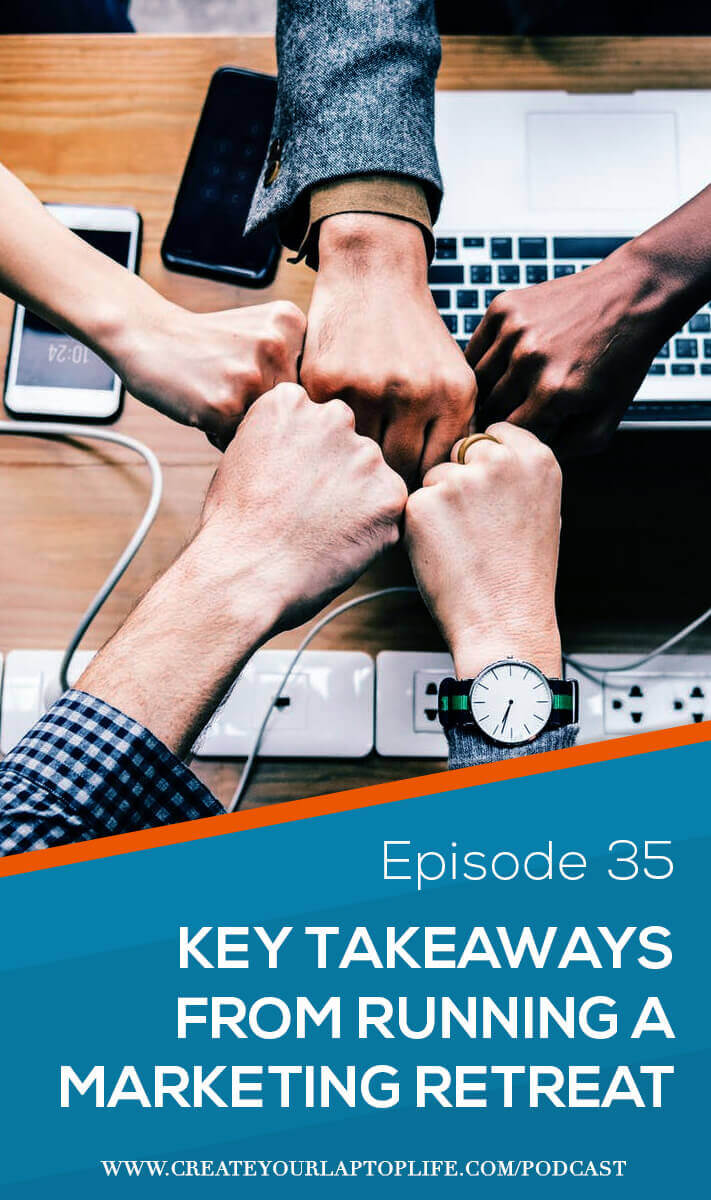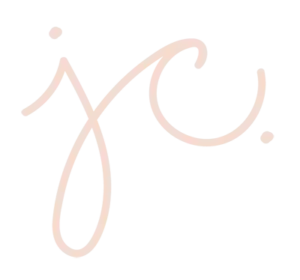Subscribe On:
Full Transcript:
Today I want to talk to you about running your own marketing or team retreat. In fact, it doesn’t really have to be a marketing retreat. It can be any sort of team retreat in your business, whether you’re just a team of 2, team of 3, team of 10. One of the reasons why it’s been so long since I recorded a podcast is because I’ve only been home 3 days
in the last 2 weeks.
And that’s because I went to Boise to run the first ever Marketing Retreat for Clickfunnels. I came home for 2 days, 3 days and then turned around and went and spoke at Clan Con.
So I have lots of stuff to catch you up with, so I’m going to go right ahead and dive right in. So about two weeks ago I ran the first marketing retreat for Clickfunnels, and I want to talk about some of the things that we implemented, that you can implement in your retreats and team meetings. The first thing is that we wanted to make sure that we had taken the dedicated time to actually get to know each other. So that’s sort of one of the reasons that we did this retreat in the first place, because we get so busy, we’re running, running super fast, we’re all over the country, and we add new team members, and it can be very, very difficult to bond, especially in that setting. And we all know that teams that have bonded together are going to perform much better than teams that are all sort of disconnected.
One of the things that you need to do in order to create and facilitate that bonding that happens at a retreat is to make sure that you set it outside of a normal location that people are used to. So we specifically did not do it in the Boise office, we did not do it anywhere where people typically work. We rented a home and got everybody in the home together. A home also fosters a lot more intimacy than say, a hotel, or conference where everyone can sort of scatter. It forced us to have our meals together, and there were lots of different nooks and crannies in the house where people could hang out. So those two things alone, like making the time to help and make sure your team really knows and communicates well, and also setting aside a location that’s not a location that you normally hang out with.
So the next thing I want to talk about is creating the atmosphere for creativity and growth. So one of the things that we did, right at the beginning of the week is I introduced the concept of the six hats. This is not my invention, I’ve, now of course the name escapes me, of the person who wrote the book. But it’s a brainstorming principle that helps people understand what hat they wear when you’re in a meeting where you’re discussing a new idea. So there’s six hats, let me run through them really fast. So the blue hat is the hat that is very planning based, writes lists, organizes things, so since we’re talking about a business and this is a business and marketing podcast, if you were planning a funnel or the business, the blue hat would be the hat that you wear when you’re in your project management software putting out deadlines, writing checklists, etc, etc. The white hat is the factual hat, this is the statistics and the analysis. So again, if you’re building a funnel, the white hat is going to look at conversion percentages, benchmark statistics, the budget of how much traffic you would run, and what you would expect as a return on ad spend, so the white hat is very analytical, it’s not very concerned with emotion. Speaking of the next hat, we’ve got the red hat next. The red hat is the emotional hat. That’s the hat that you know, when you’re responding to an idea, a business idea or maybe a hook or story, or offer, you’re thinking about what’s that emotional reaction I have to this new product. The green hat is the creative, the possibility hat. This is, I joke this is the hat that Russell wears so well. He always has new ideas, “What if we did it this way? Or what if we did it that way?” So the green hat is just the hat of possibility. The next hat is the yellow hat. The yellow hat is what you would expect, positive, sunny. Really this is the hat when you’re brainstorming the positive results, values, benefits of whatever it is that you’re planning. Then we come to black hat. The black hat is the hat that looks for problems, looks for difficulties, looks for the holes. So all these six hats are needed to have an effective project, like taken from ideation taken all the way to execution.
So I explained that to the team and so a couple of things that we did during the marketing retreat that really helped. The first thing is I identified when a meeting was very blue hat oriented or green hat oriented. And that was really helpful because if someone is in the green mode and they’re in the creative mode and someone comes in with blue, it can feel really stifling. It can feel like suffocating. So I would say, “Okay, this is a green hat moment. Let’s all just think about the possibilities.” And other times I’d say, “Alright, this is a blue hat meeting, we’re really going to iron out deadlines and etails.” That preframe changes everything when you’re dealing with a group. The other thing is it creates the opportunity to express yourself without feeling judged. It’s nerve wracking to speak up in a group, it’s nerve wracking to say, “Hey, wait a second, I see a problem.” But if it’s preframed in, “Hey, let’s put on our black hats and look for the problems.” Then all the sudden there’s safety and space to actually communicate that. So something super fun happened in the meeting organically. And we were brainstorming, we were in green hat mode and brainstorming and ideas and we were writing on the whiteboard. And eventually our ideas ran out. So I noticed the transition happening in the retreat and I said, “Let’s transition to black hat. Let’s look for all the problems.” And so we started listing out all the problems and what happened is when you can appreciate that role in someone, it all the sudden sparked more ideas. Because the minute you heard a problem, someone who is very, very gifted in the green hat thinking, will all the sudden start thinking of an idea to solve the problem. So we actually went back to green after black, because black stirred the waters again. So I thought that was a cool way to look at the benefit of being the black hat. And why it’s really important we don’t get stuck in any one particular hat, because then our brainstorming is very 2D, 2 dimensional.
So we did that, so setting that stage is really helpful. The other thing we did as a company, as a team, is that we invited representatives from other departments to come to our marketing retreat. So you know, we had all the marketing team, but we invited people from product, and product are the developers and the engineers who work on the software. And this was amazing. It gave us a really
good connection point, so that the departments can start to communicate and give feedback to one another. And it also created a better communication channel and new ideas for the way marketing can help product, and product can help marketing.
So if you have a team and you have different departments, invite other people from the other departments to mingle with whatever retreat you’re focusing on because you might find new avenues and new ways to bring in more revenue and reduce refunds or whatever the issues are that your business is facing. We also shared our meals together, really helpful. People who share meals
together connect differently than people who don’t. So whenever you run a retreat make sure that you have meals planned. I would also suggest that you find time to co-work and chill in a retreat. Now, our
retreat was five days long. I would say we had probably 2 solid days of brainstorm, planning mode before we started to fatigue. I think probably the ideal scenario for a retreat is 3 to 4 days. We went 5 days so it was definitely longer. But what we realized quickly in that is that we needed to just create several hours of time each day for people to actually work, chill out, kind of let the ideas
marinate before we came back together in a group.
The last thing that I want to share about the retreat that I thought was super fun. Is we definitely took an entire day just to do team building exercises. And I led this and I will probably go into this in other podcast episodes later, because they will be too long to explain here. But we did some personality work in the morning, and I would encourage you, if you do not understand personality stuff, or you
haven’t geeked out on it, I would. You know someone who is really fun, who geeks out a lot on personality stuff is James Friell.
So anyway, there’s all different kinds of tests, there’s Myers Briggs, there’s 16 Disc, there’s the Enneagram, but understanding personality types really helps, not just in love relationships, and family, but also in work relationships as well. So we did that. And then we did a very, very fun exercise about communication, and I’ll share this because I think it’s really fun. It’s the peanut butter and jelly game. And the idea, I broke everybody up into a team. We had four teams. And the instructions were simple, it said, “An alien has come down from another planet and knows nothing about our planet. I need you
to write up the instructions to make a peanut butter and jelly sandwich.”
I gave everybody, it was about 20 minutes that they had, and they worked together to write the instructions. And on first glance that doesn’t seem that difficult, right. A peanut butter and jelly sandwich is pretty easy. Well, once it was done, is when it was done we had everyone read the instructions, and we had four different people attempt to make the peanut butter and jelly sandwich based on the instructions.
And the results were hilarious, because number one, nobody was actually able to complete making a peanut butter and jelly sandwich. Number two, the levels of completion and what the peanut butter and jelly sandwich looked like were entirely different. In fact, one team couldn’t even get their peanut butter and jelly sandwich even close to made.
And the whole point of this exercise, besides laughing hysterically, and I really hope our video team makes a little micro episode on it, because it was really fun to watch. Is that the way we communicate the way we give instruction and the way we hear instruction is subject to wild amounts of interpretation. So if you go to someone on your team and say, “This is urgent.” What urgent means to you
and what urgent means to them, is entirely different. If you don’t set things in concrete mode, or you speak in sort of endless amounts of vagueness, you are subjecting yourself and your team member to misunderstanding what you need and what you want. So it’s the importance of giving really accurate feedback. So that game was really fun. And then in the afternoon we did some exercises where we created a safe space to talk about problems and issues and things that we see that we need to be better at and we created that safe space using anonymity so they were able to write out the problems on post it notes with no names. And then we went through an exercise where we looked at who has ownership of the problem, what the problem is, why the problem is happening, and who can help resolve the problem. So that’s what we did in our marketing retreat. We came away with incredible amounts of ideas, brainstorms, project plans, new bonding experiences, connection and a new awareness of we were, as who we are as people and how we communicate.
So I encourage you to get with your team once or twice a year to set aside time to get out of the office or wherever you normally work, to rent a home and to really focus on each other, your team building and your project plans. So I hope that’s helpful, as always, I appreciate you guys. Talk soon, bye.









0 Comments